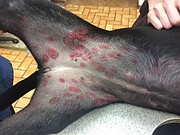Beware the biting flies
By MAUREEN DOLAN
Staff Writer
COEUR d’ALENE — Black flies are back in North Idaho, and they are out for blood.
Also known as buffalo gnats, the tiny bugs have become a spring scourge, attacking people and pets trying to enjoy the outdoors after a long, snowy winter.
And that’s part of the problem — healthy snowmelt means faster-moving rivers and streams, which are black flies’ favorite breeding grounds.
Due to their small stature, the stealthy little bloodsuckers are often called “no-see-ums,” but evidence of their bites is hard to miss.
“Oftentimes people will not feel the actual bite of the black fly, but will notice a significant amount of blood at the site followed by the development of a large swollen area and itching,” said Coeur d’Alene School District nurse Christi Allen, in a message sent to parents of students at the schools she serves, Winton Elementary and Woodland Middle.
Melanie Collett, spokeswoman for Panhandle Health District, said her office has received a recent influx of calls about the bugs.
“Black flies are a nuisance and their bites can be painful, but we want people to know the black flies in our region do not transmit disease,” Collett said.
And they can be persistent. Black flies will crawl into people’s sleeves, under neckbands and into boots. The bugs especially favor the head, just beneath the rim of a hat. Children are often bitten at the base of the hairline at the back of the head.
Black flies bite, per the Health District, to create a hole in the skin to suck blood.
“The proteins in blood assist in proper development in black fly eggs and larvae,” states the Health District’s website. “The flies most commonly attack around the eyes, ears, scalp and occasionally on the arms and exposed legs. The pain and swelling of the bite are due to the body’s allergic response to the fly’s saliva that they inject when feeding.”
The Coeur d’Alene School District’s head nurse, Cindy Perry, said school nurses are seeing bites on students and also on nurses returning to work after the holiday weekend.
“The cases we have seen are mild and our nurses treat with a tea-tree-based cooling gel. We do not use medical ointments in schools without parents’ permission,” Perry said. “This gel does work well to take the sting out and alleviate the itching ... Prevention is the best cure. I suggest insect repellent.”
The school district’s health services department recommends parents and guardians keep the site of any insect bite clean and watch for signs of infection such as fever, nausea, fatigue and drainage from the area. Parents are urged to contact their family physician if any of those signs are present or for additional recommendations.
Dr. Elisa Parker, a veterinarian at Prairie Animal Hospital on Prairie Avenue in Coeur d’Alene, said there must have been a significant hatch recently because there were several days when her office received at least 20 calls a day from concerned pet owners whose animals were bitten.
“It is most likely the same little black flies that are biting kids,” Parker said.
The bites on pets — usually from black flies in the grass — cause round, flat rings that look like targets.
“They look very alarming to people, but they don’t seem to bother the dogs. They don’t lick or scratch them,” Parker said. “They usually go away by themselves.”
The staff at the animal hospital advises pet owners to monitor the bites and if they don’t disappear after a few days, or become swollen, medical treatment may be required because it may be something other than black fly bites.
Panhandle Health District recommends taking the following steps to avoid black flies:
- Stay away from areas where black flies are active at dawn and dusk. They are commonly encountered near rivers, ponds, pastures with livestock and near rapid-moving water. Black flies are sensitive to weather conditions. They are most active on cloudy, humid days with low wind.
- Wear light-colored clothing, like white or tan. Also consider wearing long-sleeves, pants and a hat.
- Mow or trim tall grass and weeds on your property to reduce areas for black flies to live and breed.
- Use bug repellent as directed.
- If you believe you have been bitten, wash the bite and the surrounding skin before applying anti-itch creams.
Info: panhandlehealthdistrict.org/blackflies





